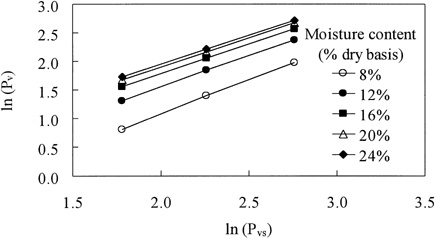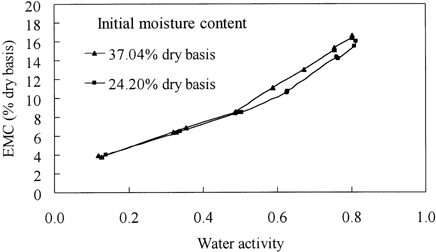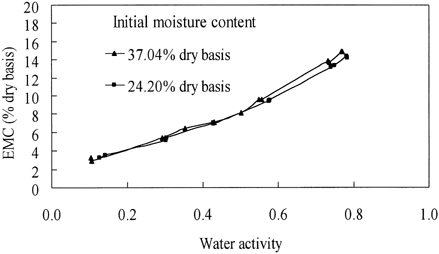ABSTRACT
The moisture isotherms of mungbean were determined at temperatures of 35, 45 and 55°C using isopiestic method. The effect of initial moisture content of mungbean on equilibrium moisture content was also studied. Five different models namely, Henderson equation, Chung and Pfost equation, Halsey equation, Sehgal equation and G.A.B. equation were used to represent the experimental data. The Sehgal equation, which provided best fit for the experimental data, was subsequently used for calculating the latent heat of moisture vaporization from mungbean based on the Othmer's equation.
INTRODUCTION
Mungbean (Vigna radiata L.) is popular in Thailand as a food grain for human consumption. It is also referred to as green gram, golden gram, chop suey bean and moong Citation[9], Citation[16]. The production of mungbean was reported to be about 200,000 tons in year 1997/1998 Citation[6]. Mungbean is planted thrice annually, and is normally harvested after moisture content decreases to about 15% (wet basis) Citation[18]. Traditional sun-drying is used to reduce the moisture content of mungbean to about 12% (wet basis) for safe storage Citation[16]. However, during rainy season in some harvest years, the moisture level of mungbean at harvest time may be substantially higher than 15% (wet basis). As a result, mungbean must be dried quickly to moisture levels safe for storage and to maintain seed qualities.
In the design and operation of grain drying and aeration systems, basic information on the equilibrium moisture content (EMC) and latent heat of vaporization (LHV) is vital. EMC is the moisture content at which the water in a product is in balance with the moisture in the surrounding atmosphere. Although the temperature and relative humidity of the surrounding air are the principal factors controlling EMC, it may also be affected by variety, composition, mechanical handling and previous moisture history. The relationship between the EMC of a product with the relative humidity of the surrounding environment or the water activity at constant temperature is commonly called the EMC isotherm.
Information on the EMC isotherms is required to optimize storage, drying, handling, and processing of agricultural products, including mungbean seeds. Another application of these EMC isotherms is in calculating the LHV of water vapor present in a food material Citation[4], Citation[21], Citation[23]. Several investigators in the past have reported works on EMC isotherms of a wide variety of agricultural and food products Citation[1], Citation[5], Citation[7], Citation[15], Citation[22]. The isopiestic method has been used extensively in the past, even though several weeks may be required before equilibrium is reached Citation[3].
The information on EMC isotherms of mungbean is very limited in the reported literature and not easily available. Therefore, the main objective of this study was the determination of the EMC of mungbean seed at different temperatures and relative humidities. The secondary objective included the development of appropriate models for the estimation of EMC and the LHV of mungbean seeds for practical applications.
MATERIALS AND METHODS
Mungbean seed (Vigna radiata L. cv. Chai Nat 36), which had been grown at Chai Nat Field Crops Research Center, Chai Nat, Thailand in 1997, was used for this study. The mungbean had approximate composition of 2l.8% protein, 44.4% starch, 4.2% fiber and 3.2% ash. Following cleaning and grading, the initial moisture content of mungbean was determined to be 8.7% (dry basis). Additional mungbean was conditioned by soaking in water to obtain samples at higher moisture contents of 17.93, 24.20 and 37.04% (dry basis). The samples were kept in double polyethylene bags and stored in a refrigerator at about 5°C for at least a week to enable the uniform distribution of moisture throughout the sample. Samples weighing about 300 g of seed were conditioned to the known temperature levels prior to testing.
Isopiestic method was used for the determination of EMCs at constant temperatures by exposing the samples to constant relative humidities maintained by saturated salt solutions. Glass dessicators containing salt solutions for maintaining six different relative humidity levels between 0.105 to 0.838 were kept in temperature controlled cabinets at 35, 45 and 55°C. The salts used were lithium chloride, magnesium chloride, magnesium nitrate, sodium nitrite, sodium chloride and ammonium sulfate. Excess salt was added to the saturated solutions to ensure that constant conditions prevailed in the course of the experiment. The temperature of cabinets was controlled to an accuracy of ±0.2°C.
Mungbean samples weighing about 30 g each were loosely placed in several stainless steel mesh baskets positioned above the saturated salt solutions in the dessicators. The time for the sample to reach equilibrium varied from 6 to 8 days depending on the initial moisture content, water activity and temperature. The moisture content of mungbean samples following equilibrium was determined by oven drying of 10 g sample of mungbean at 105°C for 24 h.
The EMCs of mungbean samples were determined at three temperatures of 35, 45 and 55°C using six different relative humidities. The effects of initial moisture content on the EMC of conditioned samples was investigated at the temperatures of 45 and 55°C. All tests were replicated twice for various combinations of temperature and relative humidity, and average values of EMC were used in the analysis of data.
The following five different EMC models proposed by Henderson Citation[12], Chung and Pfost Citation[8], Halsey Citation[11], Sehgal Citation[19] and Guggenheim-Anderson-de Boer (G.A.B.) Citation[2] were used to check their applicability to represent the experimental data:
| a w | = |
water activity, decimal |
| M | = |
equilibrium moisture content, % dry basis |
| T | = |
temperature, °C |
| a, b, c, k | = |
equation parameters |
| m 0 | = |
monolayer moisture content |
EquationsEquation1 toEquation4 representing the EMC models were transformed into appropriate forms and fitted to the experimental data based on the least-squares method. The parameters of G.A.B. model (Eq.Equation5) were determined using nonlinear regression procedure in SPSS Citation[20]. The goodness of fit of each EMC model was estimated in terms of the values of coefficient of determination (r 2) and root mean square error (RMSE). The RMSE was defined as follows:
| M expt | = |
experimental moisture content, % dry basis |
| M est | = |
estimated moisture content, % dry basis |
| n | = |
number of observations |
Higher values of r 2 with lower RMSE indicated a better fitting model.
RESULTS AND DISCUSSION
The mean values of the EMC (% dry basis) of mungbean seeds with three different initial moisture contents are presented in Tabel when equilibrated at various relative humidities of the surrounding air at three temperatures.
Table 1. Mean Equi1ibrium Moisture Content (% Dry basis) of Mungbean Seeds with Different Initial Moisture Contents When Equi1ibrated at Selected Relative Humidities and Temperature of Surrounding Air
It was observed that EMC of mungbean decreased with an increase in the temperature at any relative humidity. These results are similar to those reported for other grains Citation[14], Citation[17]. Also initial moisture content seemed to influence the EMC of mungbean, especially at 45 and 55°C for water activity above 0.5. The EMC of mungbean increased slightly with an increase in the initial moisture content as shown in Figs. and . However, the difference in the EMC was reduced with the increase in temperature.
Evaluation of EMC Models
The results of statistical analysis for fitting of five EMC isotherm models to the experimental data for mungbean are presented in Tables and for relative comparison. In all cases, relatively high values of r 2 were obtained for all models. However, there were remarkable differences in the values of RMSE. The dependence of the parameters of G.A.B. model on temperature is not accounted directly. Therefore, a direct comparison of G.A.B. model with other EMC models could not be made. It was found that both Sehgal and G.A.B. models (Eqs.Equation4 andEquation5, respectively) resulted in best fits to the experimental data because of the highest r 2 and lowest RMSE values. The Chung and Pfost and Henderson models also indicated a good general fitting but with relatively higher values of RMSE. In subsequent analysis, Sehgal model (Eq.Equation4) was selected for calculating the latent heat of moisture vaporization based on overall consideration. A plot of experimental EMC values of mungbean as a function of water activity at different temperatures is presented in Fig. along with the fitted EMC isotherms based on Sehgal model (Eq.Equation4).
Table 2. Parameters of Different EMC Models Developed for Mungbean
Table 3. The Cofficients of the G.A.B. Equation for Mungbean
Figure 3. EMC isotherms of mungbean represented by Sehgal model (Eq.Equation4)

In another study, Hirunlabh, Soponronnarit, and Vachiramon Citation[13] concluded that Halsey model provided the best fit to their experimental EMC data of mungbean as follows:
| a w | = |
water activity, decimal |
| R | = |
universal gas constant, 8.314 J/mol K |
| T | = |
temperature, K |
| M | = |
equilibrium moisture content, % dry basis |
Latent Heat of Moisture Vaporization
The procedure described by Thompson and Shedd Citation[23] was used for calculating the LHV of moisture from mungbean based on the developed EMC isotherm model (Eq.Equation4). Accordingly, a logarithmic plot of water vapor pressure exerted by moisture in grain against saturated water vapor pressure at the same temperature was obtained. Such plots, which are commonly referred as Othmer plots, were constructed for arbitrarily selected EMC values of mungbean ranging from 8 to 32% (dry basis) as shown in Fig. . The slopes of straight lines resulting from Othmer plots represented the ratio of LHV of moisture from mungbean to that of free water having values greater than 1.
Figure 4. Othmer plots of equilibrium moisture contents for mungbean showing water vapor pressure (P v) as a function of saturated water vapor pressure (P vs).

The ratio of latent heat of moisture vaporization from mungbean to the latent heat of free water as a function of moisture content is shown in Fig. . This exponential relationship was adequately represented by the following equation:
| L v | = |
latent heat of moisture vaporization from mungbean, kJ/kg |
| L vs | = |
latent heat of free water, kJ/kg |
| M | = |
moisture content, % dry basis |
This equation is obtained under the assumption that the ratio between LHV of grain to that of free water (L v/L vs) is independent of temperature Citation[10].
Figure 5. The ratio of latent heat of vaporization of moisture from mungbean to that of free water (L v/L vs) as a function of moisture content.

Figure shows that for moisture contents above 20% (dry basis), there is lift le difference between the heat of vaporization of moisture from mungbean and that of free water. Below this level of moisture content, the difference in the latent heats increases significantly. Lowering the moisture content increases the amount of energy required to remove water from product, partially due to the greater moisture binding with solids Citation[4].
CONCLUSIONS
Desorption EMC data are presented for mungbean seeds for water activity ranging from 0.105 to 0.838 at 35, 45 and 55°C temperature. EMCs of mungbean at any given constant relative humidity, decreased with increasing temperature. Also initial moisture content seemed to influence the EMC of mungbean. The results of fitting five EMC isotherm models indicated that Sehgal model provided the best fit to the experimental data. This model was subsequently used for calculating the latent heat of moisture vaporization from mungbean based on the Othmer equation. For moisture contents above 20% (dry basis), there was little difference between the heat of vaporization from the seed and that of free water.
Acknowledgments
REFERENCES
- Ajibola , O.O. 1986 . Equilibrium Moisture Properties of Winged Bean Seed . Transactions of the ASAE , 29 ( 5 ) : 1485 – 1487 .
- in press . Bakker-Arkema, F.W. Modeling of Forced Convection in In-Store Grain Drying: The State of the Art. In Preserving Grain Quality by Aeration and In-Store Drying; ACIAR Proceedings No. 15; Champ, B.R., Highley, B., Eds.; 1986; 89–95.
- Brooker , D.B. , Bakker-Arkema , F.W. and Hall , C.W. 1981 . Drying Cereal Grains 265 Westport, Connecticut, , USA : The AVI Publishing Company Inc. .
- Cenkowski , S. , Jayas , D.S. and Hao , D. 1992 . Latent Heat of Vaporization for Selected Foods and Crops . Canadian Agricultural Engineering , 34 ( 3 ) : 281 – 286 .
- Cenkowski , S. , Sokhansanj , S. and Sosulski , F.W. 1989 . Equilibrium Moisture Content of Lentils . Canadian Agricultural Engineering , 31 ( 2 ) : 159 – 162 .
- 1999 . “ Center for Agricultural Information ” . In Agricultural Statistics of Thailand Crop Year 1997/1998 309 Bangkok, , Thailand : Office of Agricultural Economics .
- Chen , Chia-Chung and Morey , R.V. 1989 . Comparison of Four EMC/ERH Equations . Transactions of the ASAE , 32 ( 3 ) : 983 – 990 .
- Chung , D.S. and Pfost , H.B. 1967 . Adsorption and Desorption of Water Vapor by Cereal Grains and Their Products . Transactions of the ASAE , 10 ( 4 ) : 552 – 555 .
- Gupta , R. , Gupta , A.P. and Agrawal , Y.C. 1991 . An Investigation of Equilibrium Moisture Content and Physical Properties of Pulses (moong, masur and urd) . Journal of Agriculture Engineering (India) , 28 ( 1–4 ) : 294 – 301 .
- Hall , C.W. 1980 . Drying and Storage of Agricultural Crops 382 Westport, Connecticut, , USA : The AVI Publishing Company Inc. .
- Halsey , G. 1948 . Physical Adsorption on Non-uniform Surfaces . Journal of Chemical Physics , 16 : 83 – 92 .
- Henderson , S.M. 1952 . A Basic Concept of Equilibrium Moisture . Agricultural Engineering , 33 ( 1 ) : 29 – 32 .
- Hirunlabh , J. , Soponronnarit , S. and Vachiramon , S. 1990 . Drying of High Moisture Grains in Humid Tropical Climates (Thailand) Bangkok, , Thailand : King Mongkut's Institute of Technology Thonburi .
- Jayas , D.S. and Mazza , G. 1991 . Equilibrium Moisture Characteristics of Safflower Seeds . Transactions of the ASAE , 34 ( 5 ) : 2099 – 2103 .
- Mazza , G. and Jayas , D.S. 1991 . Equilibrium Moisture Characteristics of Sunflower Seeds, Hulls, and Kernels . Transactions of the ASAE , 34 (2) : 534 – 538 .
- in press . Oplinger, E.S.; Hardman, L.L.; Kaminski, A.R.; Combs, S.M.; Doll, J.D. Mungbean. http://www.purdue.edu (accessed Nov 1997).
- in press . Oymael, B.; Ekiz, H.I.; Turhan, M. Adsorption Isotherms of Bulgur. http://www.confex2.com (accessed Oct 1997).
- in press . Perdomo, J.A. Some Aspects of Seed Development and Maturation in Mungbean (Vigna radiata (L.) Wilczek); M. Sci. thesis, Mississippi State University: USA, 1985; 43pp.
- in press . Sehgal, V.K. Equilibrium Moisture Content Isotherms of Rough Rice based on a Dynamic Method. M. Eng. thesis, Asian Institute of Technology: Bangkok, Thailand, 1980; 65pp.
- in press . SPSS. SPSS for Windows version 8.0. SPSS Inc., Chicago, IL., 1997.
- Tagawa , A. , Murata , S. and Hayashi , H. 1993 . Latent Heat of Vaporization in Buckwheat using the Data of Equilibrium Moisture Content . Transactions of the ASAE , 36 ( 1 ) : 113 – 118 .
- Talip , M.Z.M. , Daud , W.R.W. and Ibrahim , M.H. 1995 . Moisture Desorption Isotherms of Cocoa Beans . Transaction of the ASAE , 38 ( 4 ) : 1153 – 1155 .
- Thompson , H.J. and Shedd , C.K. 1954 . Equilibrium Moisture and Heat of Vaporization of Shelled Corn and Wheat . Agricultural Engineering , 35 ( 11 ) : 786 – 788 .

